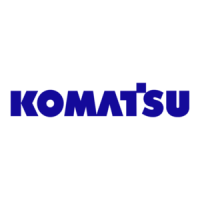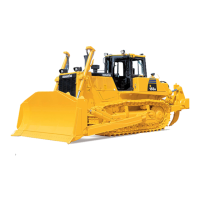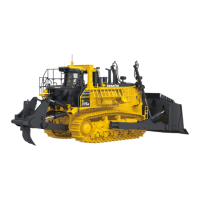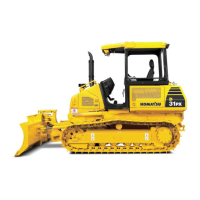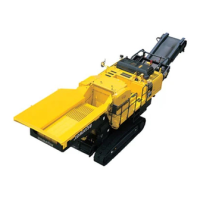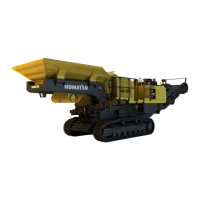FOREWORD SAFETY
00-4 b WA320-6
Preparations for Work 00
1. Before adding oil or making repairs, park the machine
on hard, level ground and block the wheels to prevent
the machine from moving.
2. Before starting work, lower blade, ripper, bucket, or any
other work equipment to the ground. If this is not
possible, insert the safety pin or use blocks to prevent
the work equipment from falling. In addition, be sure to
lock all the control levers and hang warning signs on
them.
3. When disassembling or assembling, support the
machine with blocks, jacks, or stands before starting
work.
4. Remove all mud and oil from the steps or other places
used to get on and off the machine. Always use the
handrails, ladders, or steps when getting on or off the
machine. Never jump on or off the machine. If it is
impossible to use the handrails, ladders, or steps, use a
stand to provide safe footing.
Precautions During Work 00
1. When removing the oil filler cap, drain plug, or
hydraulic pressure measuring plugs, loosen them slowly
to prevent the oil from spraying out. Before
disconnecting or removing components of the oil, water,
or air circuits, first release the pressure completely from
the circuit.
2. The engine components as well as the coolant and oil in
the circuits are hot when the engine is stopped; be
careful not to get burned. Wait for the oil and coolant to
cool before carrying out any work on the oil or water
circuits.
3. Before starting work, remove the leads from the battery.
ALWAYS remove the lead from the negative (-)
terminal first.
4. When raising heavy components (in excess of 25 kg
(55 lb)), use a hoist or crane. Check that the wire rope,
chains, and hooks are free from damage. Always use
lifting equipment which has ample capacity. Install the
lifting equipment at the correct places. Use a hoist or
crane and operate slowly to prevent the component from
hitting any other part. Do not work with any part still
raised by the hoist or crane.
5. When removing a cover which is under internal
pressure, or under pressure from a spring, always leave
two bolts in position on opposite sides. Loosen the bolts
gradually and alternately to release the pressure, and
then remove the cover.
6. When removing components, be careful not to break or
damage the wiring. Damaged wiring may cause
electrical fires.
7. When removing piping, take steps to prevent the fuel or
oil from spilling. If any fuel or oil drips on the floor,
wipe it up immediately. Fuel or oil on the floor can
cause you to slip and even start fires.
8. Gasoline or other fuels should never be used to clean
parts. Clean parts with appropriate solvents.
9. Be sure to assemble all parts again in their original
places. Replace any damaged parts or parts that must not
be reused.
• When installing hoses and wires, be sure that they
cannot be damaged by contact with other parts
when the machine is being operated.
10. When installing high pressure hoses, make sure that
they are not twisted. Damaged tubes are dangerous. Be
extremely careful when installing tubes for high-
pressure circuits. Check that connecting parts are
correctly installed.
11. When assembling or installing parts, always use the
specified tightening torques. When installing protective
parts such as guards, or parts which vibrate violently or
rotate at high speed, be particularly careful to check that
they are installed correctly.
12. When aligning two holes, never insert your fingers or
hand. Be careful not to get your fingers caught in a hole.
13. When measuring hydraulic pressure, check that the
measuring tool is correctly assembled before taking any
measurements.
14. Take care when removing or installing the tracks of
track-type machines. When removing the track, the
track separates suddenly; never let anyone stand at
either end of the track.
15. When jump-starting the machine, only use a machine of
similar size and voltage. Never use an arc welder or
other electrical generating equipment to jump-start the
machine. Carefully review the safety procedures for
jump-starting the machine.
16. Stop the engine before starting repair or maintenance
work. When working on or around a rotating part, stop
the engine. When checking the machine without
stopping the engine (measuring oil pressure, revolving
speed, temperature, etc.), take the precautions so the
machine does not move or roll over you. Do not get
caught in rotating or moving parts.
17. If the engine is operated for a long time in a place which
is not ventilated well, you may suffer from gas
poisoning. Before starting the engine, open the windows
and doors so that the area is well ventilated.
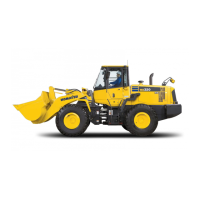
